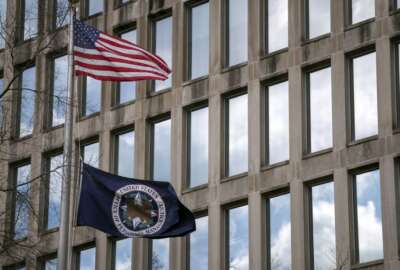Hubbard Radio Washington DC, LLC. All rights reserved. This website is not intended for users located within the European Economic Area.
IT projects pulled from brink of failure
TechStat is rarely about shutting down problematic technology programs. In an exclusive report, Federal News Radio examines how agencies are using the analys...
wfedstaff | April 17, 2015 4:04 pm
This story is Part 1 of Federal News Radio’s special report Inside TechStat.
Three major, high-dollar IT projects at the FBI, the National Archives and Records Administration plus Customs and Border Protection were about to go down in flames in 2010.
All three would have become another wreck added to the failed, large-scale federal IT project landscape.
Today, all three have pulled out of the tailspin. A major part of that 180 degree turn is the focus brought by the administration’s TechStat review program. 
Many agencies use TechStat to reinforce the solutions they have developed for their troubled projects. They used the analysis to increase the rate of change and to take more control of projects from contractors.
Steven VanRoekel, the federal chief information officer, said the government always has been good at developing programs, but not so good at fixing them once they’ve run off track.
He said TechStat has become a tool to change the culture of agencies when it comes to managing IT projects.
“A lot of times, programs come along and serve some purpose, but programs are nothing without the people around them,” he said. “The ability to use [TechStat] in your tool belt to come in as a person that’s thinking really good things around IT management and driving highly effective IT organizations like Roger [Baker] at the Veterans Affairs Department, and others, it’s about needing these things to put [the project] over the finish line and having a group effort on that, having OMB at your back and the other communities inside your organization through this TechStat process, is a great way to see it through.”
Right people at the right time
OMB introduced the idea of TechStat sessions in 2010 with a simple goal: bring senior agency managers together at one time to correct IT projects gone off course. 
Under the Bush administration in the 2000s, the White House put IT projects on one of two lists: the management watch list, which alerted senior officials about high profile, high dollar programs at their agency that needed special attention; and the high risk list, which called out programs that were in trouble.
“We’ll look at IT projects that are behind schedule, over budget and focus on problem solving,” Kundra said during a 2010 press conference announcing TechStat. “I make sure that I also have around the table the appropriate resource management officer from OMB, the branch chiefs and from the agency perspectives the CFO so we can problem solve and figure out what we need to do with IT projects, whether they need to be terminated, whether they need to be turned around or whether we need to halt them.”
Over the last two years, the government’s use of TechStat has morphed. Agencies are not using it to rescue failing IT projects, as much as they are bolstering fixes already underway.
CBP’s Automated Commercial Environment (ACE) used TechStat just for that purpose.
CBP has been working on the $3.2 billion program for more than a decade. The agency’s goal is to develop several systems under the ACE umbrella to modernize business processes.
Linda Jacksta, the executive director of the Cargo Systems Program Office and co- program manager of ACE, said the program needed to improve around three key areas: governance, contracting and acquisition strategy and system deliverables.
“When the TechStat came, it really became a good opportunity for us to come in to say, ‘We’ve already taken a look at ourselves in the mirror and really started to identify our own internal shortcomings and put in aggressive strategies to quickly start resolving some of the issues,’ ” said Jacksta. “For us, and for me as the program manager, going into the TechStat, it gave me a great opportunity to be transparent with OMB and the department about where we really are, and it really was able to show the commitment and dedication of CBP leadership and the agency to be aggressive in taking some steps to address some of those key areas.”
Nearly two years later, Jacksta said ACE’s grade on the IT Dashboard moved from red to yellow.
A growing trend
CBP’s experience with TechStat is not unusual.
The National Archives and Records Administration spent $308 million on its Electronic Records Archive (ERA) system. At one point, it too was on the cusp of failure in 2010 until officials used TechStat to help rescue the program.
Mike Wash, who has been NARA’s CIO since 2011, said the agency knew what the problems were with ERA, but it needed TechStat’s help to install much needed discipline in to the program. 
ERA is now in the operations and maintenance phase as a result of TechStat’s impact. The program now accepts multiple terabytes of data from agencies and ensures the documents are accessible forever.
Wash said TechStat also changed the typical approach to systems development.
“There’s a school of thought that’s still pretty common that things should be allowed to proceed in kind of a Skunk Works-type of fashion, we’ll develop it as we go and we’ll know when we are done when we get there,” Wash said. “What TechStat is doing is really driving in the principles that you should know what you want up front, you should have a plan for it, you should have good individual government cost estimate for what it will take to accomplish it and have a good execution plan that could be tracked well accordingly.”
The FBI’s Sentinel case management program may be one of the projects that benefited the most from TechStat’s influence on developing systems. The bureau launched the $400 million program just last month after nearly seven years of work.
Changing the contractor model
In 2010, the FBI decided to take over the systems integration role from prime contractor Lockheed Martin after struggling for years. This step is another common trait among programs that go through TechStat.
Along with the FBI, NARA and CBP also changed from having one prime contractor to controlling the program based on each task or module.
Jeffrey Johnson, the FBI’s chief technology officer, said TechStat confirmed the bureau’s decision to commit to an agile development process.
“Being able to bring developer, engineers, business analysts and requirements analysts along with policy makers and lawyers and accountants and the stakeholders of the FBI all in the same room and constantly negotiate against a working prototype of what the final system needed to be in order to have a successful transition was absolutely critical,” he said. 
Scott Stovall, the ERA program director, said TechStat fixed one of the common problems agencies have in managing large programs.
“Before we had an integrator and the integrator was given wide latitude to run the program how they saw fit,” he said. “Now we are more in control of the activities and working more directly with subject matter experts in industry. There’s that layer that now has been stripped away.”
The move away from the system integrator model also strengthened governance of agencies’ investment review boards.
VanRoekel said these boards largely and incorrectly have focused only on budget and at the expense of project performance issues.
“TechStat is a small example of that wrapped around an individual investment. I think we need to take that into an investment portfolio view and think about IT as a component of a larger motion inside the agencies,” he said. “It’s about getting the same people in the room, but looking at the mission objectives and priorities goals and how do we work back from those to make the right investments. Getting our arms around that is the key thing we are trying to do.”
Governance given boost
CBP’s Jacksta said TechStat demonstrated the need to divide and conquer when it came to governance. ACE’s project managers were juggling multiple numerous stakeholders and that was causing challenges.
She said TechStat confirmed CBP’s need to separate operations from technology and give each a dedicated focus.
Both the operations and technology offices report to an executive committee. The board has final say over the direction of ACE. The committee also held the program managers accountable for meeting the goals agreed to in the TechStat session.
“I don’t want to characterize it as a segregation,” she said. “It’s more of making sure the technology is not driving the business priorities. The business is driving the business priorities and the technology organizations are there to support and enable as quickly as possible those mission capabilities that are of greatest need to the agency.”
In NARA’s case, it reports back to OMB on a quarterly basis how agencies are using ERA.
NARA’s Wash said the TechStat approach is culture changing.
“There’s a growing acceptance of the whole process of very closely monitoring our systems in the portfolio, and if it looks like it’s going off the rails, there will be a special session,” he said. “When you come into an environment where that type of discipline is already not part of the norm, by putting it in place the first reaction almost always is, ‘Oh no, too much investigation, too much control.’ But as people realize it’s not going to be a reprimand-type-thing by going through a review process, but more of ‘let’s make sure we are properly applying our resources to meet the most critical needs of the agency, to do the right thing and do it well.’ When that spirit starts to get permeated through the organization, it gets pretty well accepted.”
MORE FROM SPECIAL REPORT INSIDE TECHSTAT:
Treasury tackles IT reviews in a new way
NASA reveals how it revived a struggling program
National archives gets ready to taste first fruits of TechStat labor
RELATED STORIES:
Mobile apps, TechStat lead OMB’s IT evolution
NARA to suspend development of ERA starting in 2012
OMB course corrects 16 IT projects
FBI to launch Sentinel this summer
FBI turns troubled into triumph with Sentinel system
Copyright © 2024 Federal News Network. All rights reserved. This website is not intended for users located within the European Economic Area.
Jason Miller
Jason Miller is executive editor of Federal News Network and directs news coverage on the people, policy and programs of the federal government.
Follow @jmillerWFED





